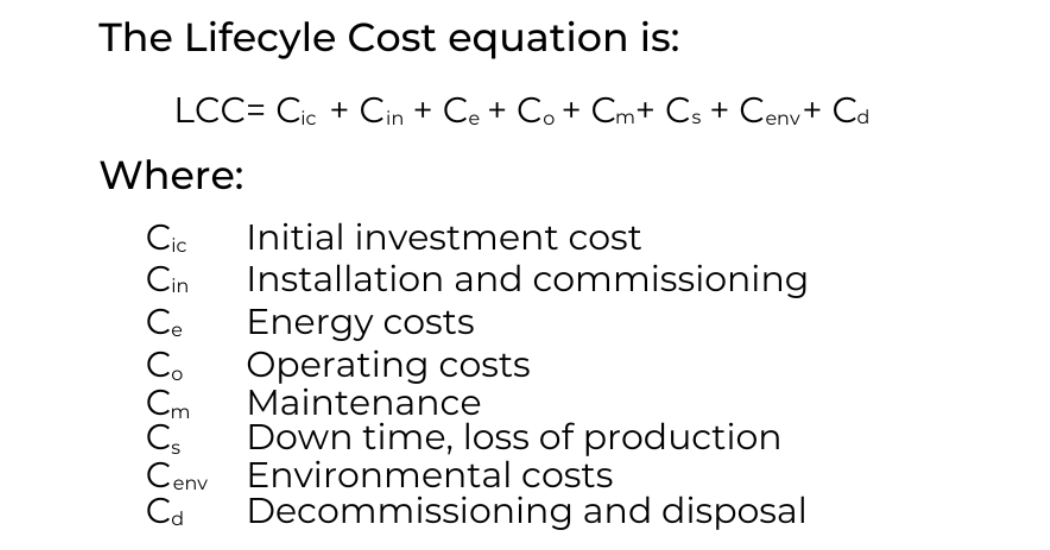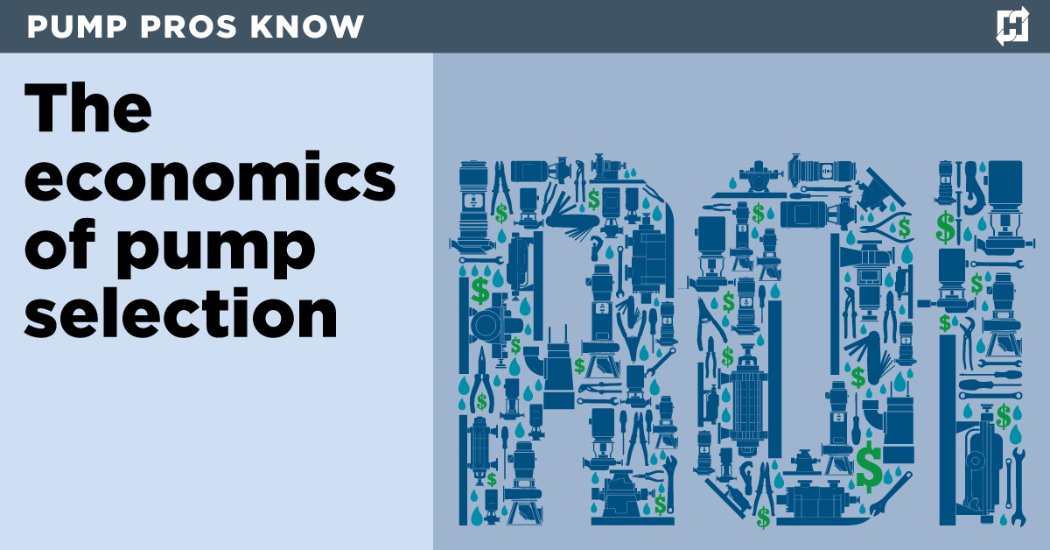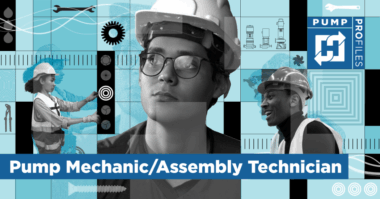What do Pump Pros Know and why do they know it? This series of articles highlights the brilliance of those who work with pumps. Read more Pump Pros Know.
Just how important is the up-front price of pump system components? Probably a lot less important than most people think.
Over a 15-to-20-year lifespan, the initial price of a typical medium-size industrial pumping system is only about 10 percent of its total cost. That compares to 40 percent for the energy needed to run it and 25 percent for the maintenance needed to keep it running efficiently. Other factors making up the remaining 25 percent include operations, installation, environmental and downtime.
Those costs add up. According to the U.S. Department of Energy’s Motor Market Assessment, industrial motors consume 25 percent of U.S. electrical energy and within that bucket pump systems represent the greatest opportunity for efficiency improvements with a midrange savings of 20 percent.
Although it seems logical to minimize the initial investment (purchase price, installation, controls, commissioning, etc.), this often leaves a legacy of higher energy and maintenance costs. The alternative is to quantify a system’s cost over its entire service life to minimize ongoing costs during operation.
This can be an involved process. To help pump owners navigate it, the Hydraulic Institute, in cooperation with Europump, developed a guidebook, Pump Life Cycle Costs: A Guide to LCC Analysis for Pumping Systems. It includes detailed methodology concerning the factors and calculations needed to estimate a pump’s life cycle cost (LCC). These analysis tools enable companies to compare alternative designs to determine which will provide the lowest costs over a system’s lifetime.
LCC analysis takes a systems approach. While pumps have grown increasingly efficient, they are often purchased as individual components. Yet they operate only within larger hydraulic systems that include motors, variable frequency drives, pipes, instrumentation and controls, and auxiliary support equipment. The LCC of a complex system depends on many interdependent factors and requires a thoughtful analysis.
Cost Factors
To better understand how different cost factors affect pumping system LCC, let’s look at them one by one.
 Initial investment. Most engineers examine initial costs first. While many factors determine cost, equipment durability is at the top of the list. Choosing equipment with heavier duty bearings and seals or more flexible controllers might cost more up front, but such systems are likely to last longer and require less maintenance over time.
Initial investment. Most engineers examine initial costs first. While many factors determine cost, equipment durability is at the top of the list. Choosing equipment with heavier duty bearings and seals or more flexible controllers might cost more up front, but such systems are likely to last longer and require less maintenance over time.
When it comes to up-front pricing, piping typically presents many tradeoffs. Smaller diameter pipes and fittings lower acquisition cost, but they require larger pumps to overcome friction resistance. Smaller pipes on the pump’s inlet side may also reduce net positive suction head available (NPSHA), which means spending more on larger, slower-speed pumps that are more costly to operate.
Performance testing is an underappreciated initial cost. While the tighter tolerances needed to achieve higher test grades increase pump cost, they may also reduce operating costs over time. While some other initial costs, such as engineering, bid and purchase order management, and testing and inspection are largely similar among pump systems, the cost of spare part inventory and auxiliary equipment for cooling and sealing water could vary widely.
Installation and startup. Installing and new commissioning larger pumps is often a complex process. It includes foundation preparation: connecting pipes, wires, instruments, auxiliary systems, and other utilities; system flushing and water runs; and performance evaluation. Training operators to run the system is also a crucial element in bringing a new pump on line successfully. These LCC costs are similar for similar types of pumping systems but may show larger variances when reviewing different types of hydraulic systems.
Energy. Energy is usually the largest single expense over a pumping system’s lifetime. This is especially true for pumps that run more than 2,000 hours per year.
In order to conduct an LCC analysis, plant designers must first gather data. This starts with understanding plant and pumping system operating cycles. If pump system output is essentially flat, the calculation is simple. If it varies over time, engineers must graph output variations and analyze usage to determine the time their pumps will spend delivering various output rates.
Designers must then collect data from each pumping system under consideration over its output range. This will vary with both pumps and drivers. It is also important to understand how throttling valves, pressure relief, and bypass piping reduce system efficiency and increase energy consumption.
This makes it possible to plot the total energy used by the pumping system over the plant’s operating cycles. Adding in the energy and material consumption costs of heating and cooling circuits, flush lines, and other auxiliary services will provide a more complete picture of energy LCC for each pump under consideration.
Operations. Operating costs are the cost of labor required to run a pumping system. They include monitoring the system for such performance indicators as vibration, shock pulses, temperature, noise, power consumption, rate of flow, and pressure as well as performance maintenance on its components.
Labor costs vary widely with system duty and complexity. The more automated a pumping system, the less supervision it will require over its lifetime. On the other hand, a hazardous duty pump may require daily checks for reliability, performance, and leakage.
Maintenance and repair. It takes regular maintenance to maximize a pump’s working life and keep it within specification. Allowing a pump to drift too far outside its best efficiency point (BEP) can actually damage the pump, reducing its efficiency and increasing its likelihood of failure.
All manufacturers provide guidelines for system maintenance. Costs vary with time and frequency of service and the cost of consumables and other replacement parts. Pump design can also make a difference, since some equipment is easier to access for service than others. When computing the cost of maintenance, include the full burden (overhead) of labor plus any training costs.
LCC analysis should also account for unexpected failures, most commonly in seals, bearings, impellers, valves, ports, couplings, and motors. Pump manufacturers should provide users with mean time between failure (MTBF) estimates for these parts. Treating this information statistically will enable users to better estimate the likelihood (and cost) of unexpected failures over a pumping system’s lifecycle.
Downtime and lost production. In many factories, the cost of unexpected downtime and a few days of lost production can dwarf the amount of money spent on a pumping system. The most common strategy to cope with pump failure is to install a spare pump for critical processes. This reduces the risk of lost production and enables engineers to rapidly return a facility to full operation. While adding an extra pump is expensive, it may look less costly after quantifying the cost of an unscheduled shutdown, lost production, and emergency repair.
Environmental. Environmental costs include handling cooling water and packing box leakage, hazardous pumped products, used lubricant, and contaminated seals and other used parts. The cost of managing these materials may vary greatly, depending on the composition of the pumped product and the investments companies make to minimize contamination of the pump’s lifecycle.
Decommissioning and Disposal. Different pump systems designs have minor impact on disposal costs. This is certainly true for non-hazardous liquids and, in most cases, for hazardous liquids as well. While the disposal of toxic, radioactive, and some regulated hazardous materials are often regulated, they vary little among system designs.
Costs of final disposal and restoration of the local environment must be evaluated accurately to assess the true LCC of pumping systems. No evaluation is needed where the numbers show there is no significant difference in the disposal of different pumping systems. Where disposal is expensive, however, the LCC becomes much more sensitive to the useful life of the equipment.
Making the Case
When summed together, these eight factors—from initial investment to end-of-life disposal—determine the lifetime cost of a pumping system. To understand their financial impact, however, we also need to consider such financial measures as present costs, but future costs (inflation rate), and the time value of money (interest rate) over the investment period.
These factors enable operators to calculate the present LCC for design options for a new plant or for comparing a less efficient pumping system with new equipment upgrades.
These financial factors will help managers assess pumping systems based on lifecycle cost analysis. While tracking down the data needed to conduct an LCC analysis will take time and effort, the results promise to enhance the efficiency and competitiveness of any new facility or upgrade that relies on pumping systems.
Assessing Upgrade Options
This table summarizes initial investment and annual cost savings for three possible ways to address a system with frequent control valve failures due to poor design.
 All three options will reduce valve maintenance costs, but options B and C also save energy. This example starts with initial costs of $2,200 to $21,500 and summarizes the cashflow, payback, and internal rate of return for each investment option. All are attractive investments, but option B, with a 372 percent internal rate of return and a cumulative discounted cash flow of $45,838, is clearly the best choice over the eight-year investment period considered here.
All three options will reduce valve maintenance costs, but options B and C also save energy. This example starts with initial costs of $2,200 to $21,500 and summarizes the cashflow, payback, and internal rate of return for each investment option. All are attractive investments, but option B, with a 372 percent internal rate of return and a cumulative discounted cash flow of $45,838, is clearly the best choice over the eight-year investment period considered here.
Failing control valve: Summary cash flows and payback for three options
 This brief introduction seeks only to highlight the factors included in LCC analysis. It only scratches the surface. The Hydraulic Institute publication, Pump Life Cycle Costs: A Guide to LCC Analysis for Pumping Systems, dives into the details of system design, including initial investments that may increase LCC. It walks pump system professionals through the data and calculations needed to perform lifecycle analysis and the steps required to analyze those results for management.
This brief introduction seeks only to highlight the factors included in LCC analysis. It only scratches the surface. The Hydraulic Institute publication, Pump Life Cycle Costs: A Guide to LCC Analysis for Pumping Systems, dives into the details of system design, including initial investments that may increase LCC. It walks pump system professionals through the data and calculations needed to perform lifecycle analysis and the steps required to analyze those results for management.
It also contains detailed information of pumping system design, the single most important element in minimizing the LCC. It covers many of the tradeoffs designers and managers are likely to face as they balance initial costs and long-term energy, maintenance and operating costs of pumps, drivers, piping, and controls.
You can learn more about Pump Life Cycle Costs: A Guide to LCC Analysis for Pumping Systems by clicking here.




